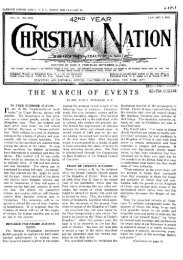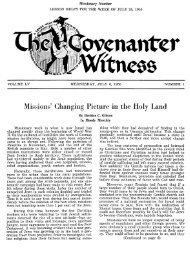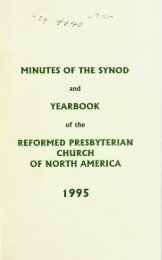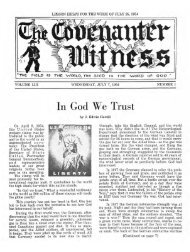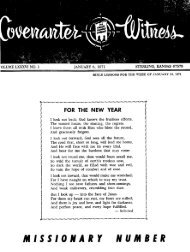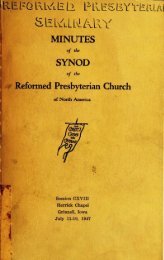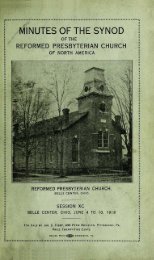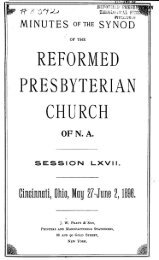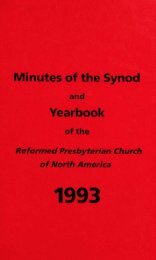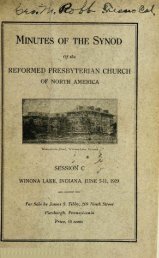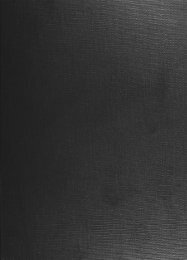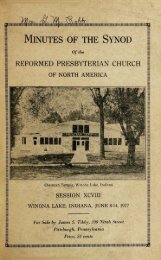S C R I B N E R ' S M A G A Z I N E Important ... - Rparchives.org
S C R I B N E R ' S M A G A Z I N E Important ... - Rparchives.org
S C R I B N E R ' S M A G A Z I N E Important ... - Rparchives.org
You also want an ePaper? Increase the reach of your titles
YUMPU automatically turns print PDFs into web optimized ePapers that Google loves.
6<br />
THE CHRISTIAN<br />
NATION.<br />
Vol. 59.<br />
because the vast majority of the people of<br />
this coimtry, irrespective of Churches or denominations,<br />
are convinced that it depends<br />
not on human law, but upon a bigher and a<br />
greater law, which we are all bound in conscience<br />
to- obey." The visible Sabbath desecration<br />
which we would restrain by human<br />
law is not tbe great source of this sin. Long<br />
Ibefore a person openly breaks the fourth<br />
command, he has broken it many times in<br />
thought and desire. The unnecessary work,<br />
the entertainment, the game, the pleasure<br />
ride, only give men an opportunity to display<br />
-that which is within their hearts. Only<br />
by checking the evil desires of our hearts<br />
in this matter, w-iill we be able to avoid<br />
the larger and more open forms of Sabbath<br />
desecration, to set an example of rectitude<br />
and to influence others by our words.<br />
Cyrus going to fight against Scythia, coming<br />
to a broad river and not being able to<br />
pass over it, cut and divided it into many<br />
arms and sluices, and) so made it passable for<br />
all his army. So the great flood of Sabbath<br />
desecration • is made up -chiefly of small, individual,<br />
invisible offences against the Divine<br />
command, "Remember the Sab-bath day to<br />
keep it holy." If each' one will reform his<br />
cwn small offence against the Sabbath we<br />
shall soon be past the great flood itself. All<br />
the profanations of the Sabbath can not be<br />
•conquered at once, but they can be conquered<br />
one by one by persistent faithfulness.<br />
We<br />
submit the following resolutions:<br />
I. That Synod renew its condemnation<br />
of every form ofl Sabbath desecration and<br />
urge our people to keep the Sabbath as a<br />
day sacred to the worship of God.<br />
II. That our ministers, be instructed to<br />
preach frequently on the subject of Sabbath<br />
observance, emphasizing the fact that the<br />
Sabbath is a primitive, a permanent and a<br />
Divine institution and giving praictical and<br />
timely instruction as to its proper observance.<br />
III. Thatj the sessions be urged to exercise<br />
a watchful oversight that members do<br />
not yield to any of the prevalent forms of<br />
Sabbath desecration, and when it is known<br />
that any one has turned aside from the<br />
strict observance of the Sabbath, reproof be<br />
administered before the offence becomes notorious<br />
and the conscience becomes seared.<br />
IV. That parents seek earnestly to impress<br />
upon the hearts of their children, by precept<br />
and example, that the Sabbath is a holy day,<br />
and sacredly devote the day to their Christian<br />
instruction at Ihome and in the sanctuary.<br />
and to strengthen them against yielding to<br />
the prevalent forms of Sabbath desecration<br />
about their homes.<br />
V. That our ministers request the ministers<br />
of other denominations who live in<br />
their community to unite with them in<br />
preaching on Sabbath observance.<br />
Signed Iby H. G. Patterson, Thos. Mc<br />
Fall, H. H. Ge<strong>org</strong>e.<br />
^^'^^ Sabbath School<br />
Lesson VI. August lo, 1913.<br />
By the Rev. W. A. Aikin.<br />
THE PASSOVER.—Exodus 12:1-42.<br />
Golden Text.—The Son of man came not<br />
to be ministered unto, but to minister, and<br />
to give his life a ransom for many.—Matt.<br />
20:2&.<br />
Psalms.—85 :i-4. L.M.; 51 -.S-g.ys.; 91:9-i3.<br />
C. M.<br />
Time.—B. C. 1491. Shortly after the plague<br />
of darkness. The fourteenth day of the<br />
month Abib. This month was called Nisan<br />
after the Babylonish captivity. It came at<br />
the earing time of -the barley and) about correspo-nds<br />
to April of the Christian calendar.<br />
It was the first month of the Jewish ecclesiastical<br />
year.<br />
Place.—Goshen, in Egypt.<br />
ANALYSIS AND COMMENT.<br />
In the account of the instituting of the passover<br />
and the exit of Israel from Egypt, recorded<br />
in the twelfth chapter of Exodus, we<br />
have in type the first full statement of the<br />
gospel. The story of tbe Cross is here told<br />
in the rich and simple terms of ceremonial<br />
type, with, all the beauty and attractiveness<br />
of "apples of gold in pictures of silver."<br />
I. THE PASSOVER, INSTITUED OF<br />
GOD.<br />
"And the Lord spake unto Moses, etc." As<br />
Paul was directed of the Lord in the institution<br />
of the Lord's Supper, so- "Aloses received<br />
of the Lord the instructions for instituting<br />
the Passover. It was "not of men,<br />
neithier by man, but by Jesus Chrlist, and God<br />
the Father." The appointment of the use of<br />
certain types and' ceremonies belonged to<br />
Him, who was to accomplish by the shedding<br />
of his own blood, those things which<br />
were signified by the types.<br />
II. THE PASCHAL LAMB.<br />
"Tbey shall take every man a lamb, according<br />
to the house of their fathers, a<br />
lamb for an house, etc." The paschal lamb<br />
and the manner in which it was to be killed<br />
and eaten was of deep significance.<br />
1st. It typified Christ. Christ is in<br />
-scripture called, "the lamb of God, which<br />
taketh away the sin of the world. Because<br />
of its disposition, color, habits and use, the<br />
lamb is of all animals best fitted to typify<br />
Christ. And the paschal lamb being without<br />
blemish and without spot" forshadowed<br />
his complete sinlessness.<br />
2nd. It foretold the strength of the Messiah.<br />
The lamb was to be "a male of the<br />
first year." It was then in its prime. Christ<br />
was not offered! up in infancy but at the<br />
time when he was in the exercise of the<br />
full powers of manhood.<br />
3rd, It foretold the coming of Christ "in<br />
the fulness of time." The lamb was to be<br />
held in readiness for some days, but not to<br />
be slain until the appointed time. "And ye<br />
shall keep it up until the fourteenth day,'j<br />
4th. The slaying of tbe lamb foretold J<br />
death of Christ. "He was led as a lar<br />
to the slaughter." Again, "Christ, our pas<br />
over, is sacrificed for us."<br />
' j<br />
5th. The saving of the shed blood in<br />
basin signified tbe conserving of the beneii<br />
of Christ's atoning work through the co<br />
enant of grace.<br />
6th. The roasting of the lamb mj<br />
foretold the exposure of Christ to thej<br />
suming wrath of God.<br />
7th. The unbroken bones of the lamb'd<br />
clared that the strength of the Savior w<br />
not to- be impaired by his sufferings at<br />
death. As the divine nature of Christ'w<br />
to him in his work as Savior what fihe strt<br />
ture of bones are to the body, the no'<br />
breaking of the bones of the lamb may:!<br />
nify that his divinity was not to be impai<br />
in his death.<br />
HI. THE SPRINKLING OF T]<br />
BLOOD OF THE LAMB ON THE L]<br />
TELS AND DOOR-POSTS. 4<br />
"And they shall take of the blood, <<br />
strike on the two side posts and on the •<br />
per posts of the houses, wherein they^ si<br />
eat." A few of the things may be ne<br />
which this act signified.<br />
d<br />
1st. It signified the sealing of theo<br />
enant of grace. The passover was of '<br />
natijra of a covenant. And as the scai<br />
thread which Rahab placed in the wind<br />
established tbe covenant between her andl<br />
spies of Israel, so the blood sprinkled on*<br />
door posts was a seal of the covenant betwi<br />
God and Israel. Thus in sprinkling t<br />
blood on th,e door posts Israel saw befi<br />
hand "the blood of the new testament, wh<br />
is shed for many for the remission of sitii<br />
2nd. It signified Israel's faith in Gc<br />
promise. Their obedience evidenced tl<br />
faith. Belief on Jesus Qhrist declares f;<br />
in the promises of God.<br />
^<br />
3rd.<br />
It signified the making of a pu<br />
profession of faitb. God has made no pn<br />
ises to- those who desire the benefits-<br />
Christ's salvation but who fail to coni^<br />
him before men. The blood was tof'<br />
sprinkled in a place where passers-by';mi'<br />
see it. * A#!<br />
4th. It showed the necessity for the *'<br />
plication of the blood of Christ. It was^'<br />
sufficient that the blood of the lamb sin<br />
be shed. It must also be sprinkled. Witt'<br />
the work of the Holy Spirit in applying"<br />
blood of Christ, his work must be in vaii<br />
Sth. The sprinkling of the blood upon<br />
lintel above. the door and on the side p<br />
but not upon the threshbld signified theSJ<br />
tity of the blood of Christ. It was not^'<br />
trampled underfoot. "Of how much: sc<br />
punishment, suppose ye, shall he -be thou<br />
worthy, who hath trodden under foot<br />
Son of God, and hathi counted the blood<br />
the covenant, wherewith he was sanctified,



